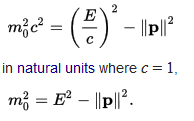I am curious as to how Photons began moving to begin with. Were they moving when they were first created or did some force have to act on it to start its movement?
-
1$\begingroup$ Possible duplicate: physics.stackexchange.com/q/20289/50583 and its linked questions. $\endgroup$– ACuriousMind ♦Commented Oct 19, 2016 at 16:01
-
1$\begingroup$ Another possible duplicate: physics.stackexchange.com/q/94049/2451 $\endgroup$– Qmechanic ♦Commented Oct 19, 2016 at 16:15
5 Answers
An alternate point of view is to look at photons as a perturbation in the electromagnetic field. Consider a positive charge at rest. From it emerges an electric field whose lines extend in the universe, at the speed of light. This speed of light is maybe to be seen as the maximal speed at which any perturbation can be transmitted rather than the speed of light itself. Now if you start to move the charge back and forth, ripple will appear on those lines, propagating at this maximal speed (like a wave on a string), the speed of light. But photons are just quanta of this excitation of the field, hence they propagate at the speed of light.
You can see this with this in this animation :http://www.tapir.caltech.edu/~teviet/Waves/empulse.html Or with this applet: https://phet.colorado.edu/sims/radiating-charge/radiating-charge_en.html
In a sense your question is also why waves propagate a the speed they do. The answer lies in the medium properties, which in the case of light is vacuum, and its properties are the the vacuum permittivity and permeability.
I am curious as to how Photons began moving to begin with.
Electromagnetic radiation, hence photons, is created by forces between charged particles, and it starts off its motion at the speed of light, and continues moving at that speed for the rest of its existence.
Were they moving when they were first created or did some force have to act on it to start its movement?
They were moving when they were first created. You can test this by sending an alternating current into a radio transmitter then picking up the signal at another antenna, and you'll find that the radio waves were created and started moving instantly as the alternating current changed. Unfortunately I don't have a reference for this experiment, but I am sure it is so since if not, we would have noticed a long time ago.
I guess light in vacuum always travel at speed of light ,so when you heat up an object it gives a photon that has an initial velocity c and continues travelling at that speed. Photons still can be accelerated in gravitational fields , by bouncing off mirrors or by travelling through different media
Light is composed by a confluence of photons, and it is photons that have always velocity c, whereas light in a medium can display lower velocity.
Were they moving when they were first created or did some force have to act on it to start its movement?
Force is not a concept very relevant to photons, because it is a macroscipic classical definition. In the microworld (small dimensions commensurate with h_bar,) of quantum mechanics, there exist only interactions and conservation laws.
A dp/dt appears in most interactions,and photons appear from transitions of charged particles losing momentum in fields , and by momentum conservation the photon with its zero mass picks up the balance.
Photons are also created by transitions in bound state energy levels, and again momentum and energy conservation define the energy of the photon. Since they have zero mass their speed is always c, according to the relativistic formula
That photons have zero mass is an experimental fact, i.e. in energy and momentum conservation balances always the mass of photon is zero.
In that sense they are moving with velocity c as they are born, whole, during the interaction.
-
$\begingroup$ Dear Anna, I'd appreciate if you take a look at this (and if possible answer it): physics.stackexchange.com/questions/287730/… $\endgroup$ Commented Oct 21, 2016 at 2:38
Light speed being a constant, photons can not accelerate nor decelerate. It is part of the nature of light that it is always measured as moving at speed $c$.
The key point is that no observer can identify with light: no valid frame of reference can move at the speed of light relatively to another. Intuitively one could say that for proper observers space and time are exterior dimensions that can be, well, observed, and measured; on the other hand, for light, time does not seem to flow as far as we can tell (which, strictly, we can not, since no observer can follow a photon...) and space has no meaning at least in the direction of propagation, so overall space and time now do not behave as external dimensions: in some sense, light is not moving at all, it is enmeshed in spacetime itself.
This can be seen by considering the rapidity of light: rapidity is a good way to define a relativistic speed, because it is additive (along one dimension) and has no upper bound. Light has an infinite rapidity, which shows that it does not move at all like any other "thing" moves because it lives at an absolute limit of the relativist $space \& time$ framework allowing to define what speed is (the $space/time$ ratio).

